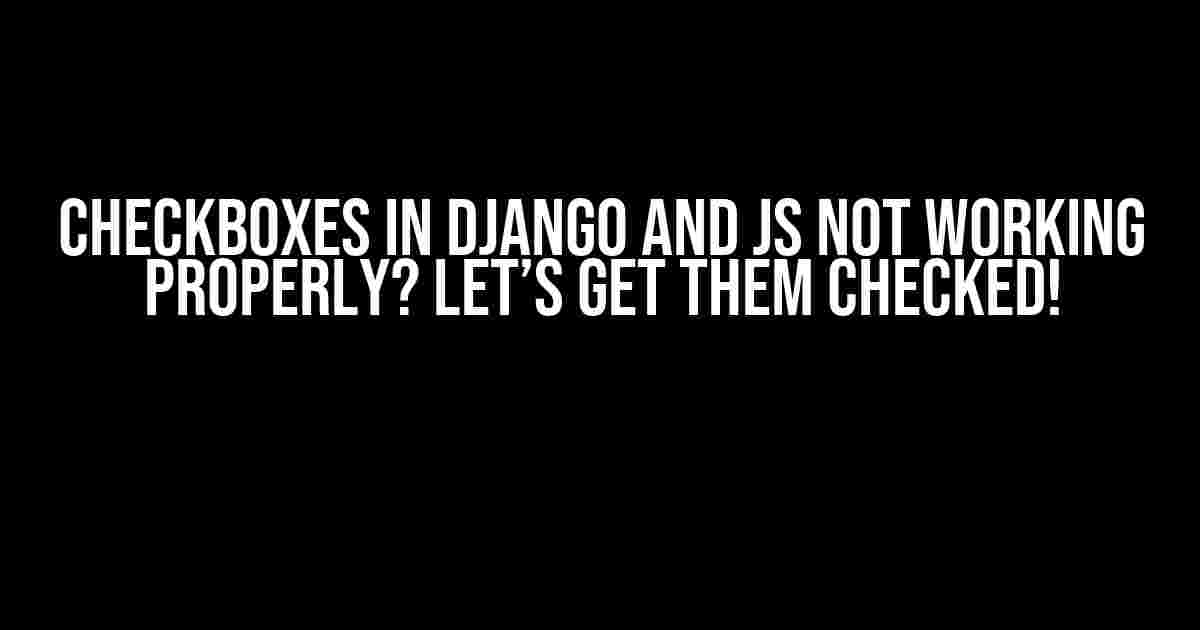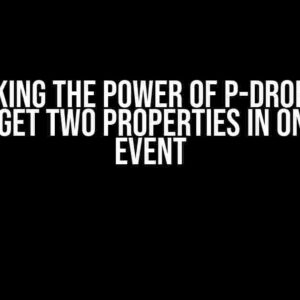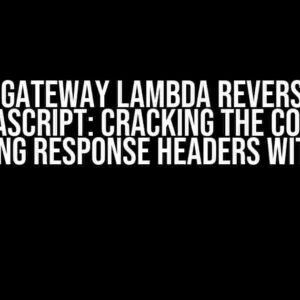Are you tired of dealing with pesky checkboxes in your Django project that just won’t behave? Do you find yourself scratching your head, wondering why your JavaScript code isn’t interacting with your Django checkboxes the way it should? Fear not, dear developer, for we’ve got the solution for you! In this article, we’ll delve into the world of checkboxes in Django and JavaScript, and provide you with clear, step-by-step instructions on how to get them working properly.
The Problem: Checkboxes in Django Templates
When working with Django templates, you might have noticed that checkboxes don’t quite behave as expected. You might have tried using the built-in `checkbox` widget in your Django forms, only to find that it doesn’t work as intended. Or perhaps you’ve tried using JavaScript to manipulate the checkboxes, but to no avail.
The reason for this is that Django’s built-in `checkbox` widget uses a rather complex HTML structure, which can make it tricky to work with. Specifically, the checkbox is wrapped in a `div` element with a `widget` class, which can cause issues when trying to target the checkbox using JavaScript.
The Solution: Using a Custom Checkbox Widget
One way to solve this problem is to create a custom checkbox widget that uses a simpler HTML structure. We can do this by creating a custom widget class in our Django app:
# myapp/widgets.py
from django.forms.widgets import CheckboxInput
class SimpleCheckbox(CheckboxInput):
template_name = 'simple_checkbox.html'
In this example, we’ve created a `SimpleCheckbox` class that inherits from Django’s built-in `CheckboxInput` class. We’ve also specified a custom template name, `simple_checkbox.html`, which we’ll use to render the checkbox.
Next, we’ll create the `simple_checkbox.html` template:
{# simple_checkbox.html #}
In this template, we’re using Django’s built-in `id_for_label` variable to generate an `id` attribute for the checkbox, and we’re using the `value` variable to determine whether the checkbox should be checked or not.
Using the Custom Checkbox Widget in Your Django Form
Now that we’ve created our custom checkbox widget, let’s use it in our Django form:
# myapp/forms.py
from django import forms
from myapp.widgets import SimpleCheckbox
class MyForm(forms.Form):
my_checkbox = forms.BooleanField(widget=SimpleCheckbox)
In this example, we’ve created a `MyForm` class that includes a `my_checkbox` field, which uses our custom `SimpleCheckbox` widget.
JavaScript and Checkboxes: Getting Them to Play Nice
Now that we’ve got our custom checkbox widget working, let’s talk about how to interact with it using JavaScript. One common use case is to toggle the checkbox based on some other action on the page.
Let’s say we want to toggle the checkbox when a user clicks on a button. We can do this using some simple JavaScript code:
// script.js
document.addEventListener('DOMContentLoaded', function() {
const button = document.getElementById('my-button');
const checkbox = document.getElementById('my-checkbox');
button.addEventListener('click', function() {
checkbox.checked = !checkbox.checked;
});
});
In this example, we’re using JavaScript to get a reference to the button and checkbox elements on the page. We’re then adding an event listener to the button, which toggles the checkbox when clicked.
Common Gotchas: Things to Watch Out For
When working with checkboxes in Django and JavaScript, there are a few common gotchas to watch out for:
- ID Attributes:** Make sure your checkbox has a unique `id` attribute, as this is used to target the element using JavaScript.
- Namespacing:** If you’re using multiple checkboxes on the same page, make sure to namespace them correctly to avoid conflicts.
- Event Delegation:** When adding event listeners to your checkbox, make sure to use event delegation to avoid attaching multiple listeners to the same element.
Putting it All Together: A Real-World Example
Let’s say we’re building a todo list app, and we want to include a checkbox next to each todo item to mark it as completed. We’ll create a custom checkbox widget, and then use JavaScript to toggle the checkbox when the user clicks on the todo item.
# todo/forms.py
from django import forms
from todo.widgets import SimpleCheckbox
class TodoForm(forms.Form):
completed = forms.BooleanField(widget=SimpleCheckbox)
# todo/templates/todo_list.html
{% for todo in todo_list %}
{{ todo.text }}
{% endfor %}
// script.js
document.addEventListener('DOMContentLoaded', function() {
const todoList = document.getElementById('todo-list');
const todoItems = todoList.querySelectorAll('li');
todoItems.forEach(function(todoItem) {
const checkbox = todoItem.querySelector('input[type="checkbox"]');
const label = todoItem.querySelector('label');
label.addEventListener('click', function() {
checkbox.checked = !checkbox.checked;
});
});
});
In this example, we’ve created a custom checkbox widget, and used it in our `TodoForm`. We’ve then used JavaScript to toggle the checkbox when the user clicks on the todo item.
Conclusion: Checkboxes in Django and JS, Made Easy!
And there you have it! With these simple steps, you should be able to get your checkboxes working properly in Django and JavaScript. Remember to create a custom checkbox widget, use JavaScript to interact with the checkbox, and watch out for common gotchas like ID attributes and namespacing.
By following these instructions, you’ll be able to create robust and user-friendly checkbox interactions in your Django project, and make your users (and your development team) very happy indeed!
| Common Checklist: |
|---|
| ✔ Create a custom checkbox widget in Django |
| ✔ Use the custom widget in your Django form |
| ✔ Use JavaScript to interact with the checkbox |
| ✔ Watch out for common gotchas like ID attributes and namespacing |
- Remember to test your code thoroughly to ensure that your checkboxes are working as intended.
- Consider using a JavaScript library like jQuery to simplify your code and make it more efficient.
Here are 5 questions and answers about “Checkboxes in Django and JS not working properly”:
Frequently Asked Question
Are you tired of struggling with checkboxes in Django and JS that just won’t cooperate? We’ve got you covered!
Why aren’t my Django checkboxes not showing up at all?
This is likely due to a missing `forms.py` file or incorrect syntax in your Django form. Make sure you have a `forms.py` file in your app directory, and that you’ve defined your form fields correctly. Also, check that you’re rendering the form correctly in your template using `{{ form.as_p }}` or `{{ form.as_table }}`.
How do I make my checkboxes toggle on and off with JavaScript?
To toggle checkboxes with JavaScript, you can use the `addEventListener` method to listen for click events on the checkbox element. Then, use the `checked` property to toggle the checkbox state. For example: `document.getElementById(‘myCheckbox’).addEventListener(‘click’, function() { this.checked = !this.checked; });`.
Why are my checkboxes not submitting with the form data in Django?
This could be due to a missing `name` attribute on your checkbox input field. Make sure each checkbox has a unique `name` attribute, and that it matches the field name in your Django form. Also, check that you’re submitting the form correctly using `method=”post”` and `{% csrf_token %}` in your template.
How do I access the checkbox values in my Django view?
In your Django view, you can access the checkbox values using the `request.POST` dictionary. For example: `request.POST.getlist(‘checkbox_field_name’)` will return a list of selected checkbox values. Make sure to use the `getlist` method, as checkbox values can be multiple.
Can I use jQuery to simplify my checkbox JavaScript code?
Yes! jQuery can greatly simplify your JavaScript code for working with checkboxes. For example, you can use `$(selector).prop(‘checked’, true/false)` to toggle checkboxes, or `$(selector).is(‘:checked’)` to check the checkbox state. Just make sure to include the jQuery library in your HTML file.




